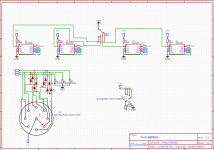BrooksBlackhawk
New member
I thought of a potential solution to the blank 5TH "Test" program on FV-1 chip. Like the arachnid but the focus being on the internal programs but with one bonus program on the the external eprom and no additional switch needed to access it.
We know that:
"ROM Programs
The FV-1 includes 8 programs in the internal ROM, these programs and the assigned potentiometer input controls are detailed in Table 1.
Table 1 - ROM Programs
Prg # Description POT0 POT1 POT2
0 Chorus-reverb Reverb mix Chorus rate Chorus mix
1 Flange-reverb Reverb mix Flange rate Flange mix
2 Tremolo-reverb Reverb mix Tremolo rate Tremolo mix
3 Pitch shift Pitch +/-4 semitones - -
4 Pitch-echo Pitch shift Echo delay Echo mix
5 Test - - -
6 Reverb 1 Reverb time HF filter LF filter
7 Reverb 2 Reverb time HF filter LF filter"
So for the 5th program, if the switch sent pin 13 high (3.3v) the external eprom kicks in right?
SEE SW_2 AT BOTTOM OF SCHEMATIC
BROOKS BLACKHAWK
We know that:
"ROM Programs
The FV-1 includes 8 programs in the internal ROM, these programs and the assigned potentiometer input controls are detailed in Table 1.
Table 1 - ROM Programs
Prg # Description POT0 POT1 POT2
0 Chorus-reverb Reverb mix Chorus rate Chorus mix
1 Flange-reverb Reverb mix Flange rate Flange mix
2 Tremolo-reverb Reverb mix Tremolo rate Tremolo mix
3 Pitch shift Pitch +/-4 semitones - -
4 Pitch-echo Pitch shift Echo delay Echo mix
5 Test - - -
6 Reverb 1 Reverb time HF filter LF filter
7 Reverb 2 Reverb time HF filter LF filter"
So for the 5th program, if the switch sent pin 13 high (3.3v) the external eprom kicks in right?
SEE SW_2 AT BOTTOM OF SCHEMATIC
BROOKS BLACKHAWK



